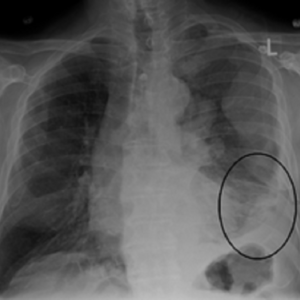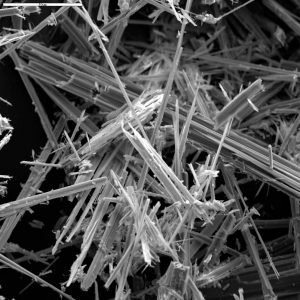What is Malignant Mesothelioma?

Malignant mesothelioma is a deadly form of usual onset cancer caused by asbestos exposure. It is an aggressive disease that begins in the tissue lining of certain body parts, specifically the lungs, abdomen, heart and testicles. It is also not easily diagnosed. Most patients do not exhibit symptoms of malignant mesothelioma for decades after exposure to asbestos — and by that time, treatment options may be limited.
Occupational exposure to asbestos is the leading cause of malignancy, which results from the inhalation or ingestion of microscopic asbestos fibers. Other people may have been exposed to asbestos in their homes, schools, hospitals or at other locations. Any amount of asbestos exposure is dangerous. Currently, there is no universal ban on asbestos in the United States.
People who have been diagnosed with mesothelioma are entitled to compensation from the asbestos companies that failed to warn workers and the public of the dangers of their products. For more information about financial help, please contact us now.
What Is Malignant Mesothelioma?
Mesothelioma is the result of mutations of the DNA within cells. The changes can cause normally healthy cells to malfunction and multiply out of control. These abnormal cells can potentially become cancerous. With malignant mesothelioma, that process may not begin until anywhere from 15 to 60 years after asbestos exposure.
So, what happens during that latent period? Asbestos fibers are microscopic, long and thin. When they are inhaled or ingested, those particles get lodged in the thin membrane surrounding some body cavities. This membrane is called the mesothelium.
The mesothelium is an important protector of the body’s vital organs, acting as a lubricant but also playing important roles in immunity, healing, fluid transport and, significantly, tumor prevention in the digestive tract.
Many people are exposed to asbestos during their lifetimes. Most do not develop malignant mesothelioma. Researchers do not have a clear understanding of what makes the difference. A person’s age, sex, work history, general health and genetic makeup are possible contributing factors.
Types of Malignancies
Mesothelioma originates in four primary areas of the body, but it can spread to other parts of the body over time. The disease’s location, cell type and stage at the time of diagnosis impact the patient’s treatment plan and prognosis.
Pleural (lungs)
More than three out of four mesothelioma tumors are pleural, making it the most common form of asbestos cancer. Tumors develop in the pleura, a membrane that covers the lungs and the inner lining of the chest cavity.
 Inhaled asbestos fibers that get trapped in the pleura can cause scarring and irritation in the respiratory region. Malignant pleural mesothelioma symptoms are often so subtle that they are mistaken for more manageable conditions such as pneumonia, bronchitis or asthma. Pleural mesothelioma may also mimic an asbestos-related disease called asbestosis or other benign lung conditions.
Inhaled asbestos fibers that get trapped in the pleura can cause scarring and irritation in the respiratory region. Malignant pleural mesothelioma symptoms are often so subtle that they are mistaken for more manageable conditions such as pneumonia, bronchitis or asthma. Pleural mesothelioma may also mimic an asbestos-related disease called asbestosis or other benign lung conditions.
The prognosis for patients with pleural mesothelioma is about one year. In addition to traditional cancer treatment methods such as surgery, chemotherapy and radiation therapy, clinical trials may be an option for some patients with pleural mesothelioma.
Peritoneal (abdomen)
This cancer that originates in the abdominal area is called peritoneal mesothelioma. The peritoneum is the thin tissue lining the belly and pelvic areas and is supported by a thin layer of connective tissue. Roughly 20 to 33 percent of cases of malignancy are peritoneal.
Patients with peritoneal mesothelioma often report symptoms such as abdominal pain, fever and unexplained weight loss. Doctors may find pleural effusion, or fluid build-up in the abdomen. The disease is often misdiagnosed as irritable bowel syndrome.
The outlook for patients with peritoneal mesothelioma is anywhere from 12 to 21 months. Treatment plans may involve using a combination of surgery with hyperthermic intraperitoneal chemotherapy (HIPEC).
Pericardial (heart)
The pericardium is a two-layer sac around the heart. Asbestos particles that get embedded in the pericardium can result in pericardial mesothelioma, but this form of the disease is very rare. Like all forms of meso, the symptoms of pericardial mesothelioma are so non-specific that they are often diagnosed as some form of heart disease.
Less is known about how asbestos fibers make their way to the heart tissue. Some experts suspect that pericardial mesothelioma is the result of metastasis from other primary cancers.
Patients with pericardial mesothelioma generally have a poor prognosis and life expectancy of about six months.
Tunica Vaginalis (testicles)
Mesothelioma of the testicle is the rarest form of the disease. The membrane surrounding the testicle is called the tunica vaginalis testis. Mesothelioma tumors grow in the membrane and cause symptoms such as swelling, fluid and a mass that is sometimes mistaken for an inguinal hernia.
Asbestos exposure is the only known cause of testicular mesothelioma. Little research has focused on diagnosing and treating the disease. The prognosis after diagnosis is generally longer that the three other forms of meso ─ as long as 20 months.
Risk Factors for Malignancy
The vast majority of mesothelioma cases can be explained by on-the-job exposure to asbestos. But not all of them. Some may be due to secondhand “take-home exposure,” where a worker inadvertently brought asbestos home on clothing or shoes and exposed family members to the invisible and dangerous fibers. Others may have been exposed in their own homes, automobiles, work or hobbies.
Most mesothelioma cases are men over age 65 who had (or have jobs) as:
- Construction workers
- Chemical technicians
- Insulation workers
- Roofers
- Pipelayers
- Pipefitters
- Automotive workers
- Railroad workers
- Steamfitters
- Firefighters
- Shipbuilders
- Military servicemembers
- Miners
- Textile mill workers
- Paper mill workers
No matter what your work history is, if you have received an asbestos cancer diagnosis, you were exposed to asbestos at some point. A knowledgeable mesothelioma lawyer can help you review your work history to determine your options for pursuing the financial compensation you and your family need.
Treatment
 Treatment for mesothelioma depends on several factors. Early detection is key. Unfortunately, many people are not diagnosed until they are in the late stages of the disease. By that time, the asbestos cancer may have metastasized throughout the body. In those cases, doctors might suggest palliative treatments to improve the patient’s comfort rather than a more aggressive approach.
Treatment for mesothelioma depends on several factors. Early detection is key. Unfortunately, many people are not diagnosed until they are in the late stages of the disease. By that time, the asbestos cancer may have metastasized throughout the body. In those cases, doctors might suggest palliative treatments to improve the patient’s comfort rather than a more aggressive approach.
Two other factors are important when evaluating treatment options ― the stage of the disease and the cell type.
The stage of mesothelioma describes the extent of the disease in the body. Doctors will look at the location of the tumors and assess how far they have spread to other tissues and organs to determine whether the cancer is a Stage I, II, III or IV.
Doctors also need to know the microscopic details about the cancer cells. There are three types of mesothelioma cells ― epithelioid, sarcomatoid and biphasic. Epithelioid tumors are easier to treat. Sarcomatoid cells are extremely resistant to therapy. Biphasic tumors are made up of both epithelioid and sarcomatoid cells. Treatment can depend on which type of cell is more prevalent. The greater the number of epithelioid cells, the better the chance for treatment.
Once a diagnosis is confirmed, a doctor may suggest:
- Surgery
- Chemotherapy
- Radiation therapy
- A combination of treatments
Some medical centers may be able to offer patients the opportunity to participate in clinical trials exploring new treatments for malignant mesothelioma. Some patients may turn to alternative or holistic therapies, such as acupuncture, homeopathic products and chiropractic care. It’s important to ask your doctor about all treatment options.
Other Asbestos-Related Diseases
Asbestos exposure has been linked to other diseases besides mesothelioma. Among them:
- Lung cancer: Unlike mesothelioma, lung cancer develops inside the lung itself. Mesothelioma begins in the outer linings of the lung. Thousands of lung cancer deaths are tied to asbestos each year in the United States.
- Asbestosis: This is a chronic, benign lung condition characterized by scarring and inflammation of the lungs that makes breathing difficult. Symptoms include shortness of breath, a dry cough, clubbing of the fingertips and toes, and chest tightness.
- Other asbestos-related diseases: Pleural plaques, rounded atelectasis, benign pulmonary conditions and some other forms of cancer are also associated with asbestos exposure.
Asbestos Exposure Still Happens Today
Although legislation has been passed to limit asbestos exposure, the Centers for Disease Control and Prevention reports that more than 1 million workers are still being exposed to asbestos on the job each day. The National Institute for Occupational Safety and Health (NIOSH) reports that current exposures predominantly happen during maintenance operations or during asbestos remediation in older buildings.
Some demographic trends suggest that incidences of mesothelioma causes are expected to decline due to restrictions placed on asbestos usage. But NIOSH cautions that new cases of malignant mesothelioma may still arise because of the current continued use and importation of asbestos products in the United States. In addition, those who were exposed years ago are still at risk for developing the deadly cancer.
People who worked directly with or near asbestos materials and have symptoms of mesothelioma should seek medical attention immediately. Talking with an experienced mesothelioma attorney can also help patients understand their legal rights to compensation after a diagnosis.
No Safe Amount of Asbestos Exposure Exists
 There is no safe level of asbestos exposure. In 1980, NIOSH reported that “there is no level of exposure below which clinical effects do not occur.” The National Cancer Institute further says that asbestos-related diseases have been found in people who had only very brief exposures to asbestos fibers. However, the disease is typically found in people who worked around or near asbestos for prolonged periods.
There is no safe level of asbestos exposure. In 1980, NIOSH reported that “there is no level of exposure below which clinical effects do not occur.” The National Cancer Institute further says that asbestos-related diseases have been found in people who had only very brief exposures to asbestos fibers. However, the disease is typically found in people who worked around or near asbestos for prolonged periods.
Rules from the Occupational Safety and Health Administration do require employers to take steps to limit who is exposed to asbestos and how long the exposure can last. While these limits are important, none of them can guarantee that a person will not develop mesothelioma.
Financial Help Is Available for Mesothelioma Patients and Families
Battling malignant mesothelioma is a costly undertaking. Getting quality medical care for such a rare disease is essential for the best possible prognosis. But paying for the necessary medical treatments can create significant financial burdens for patients and their families. The situation can become more difficult if the patient is the primary breadwinner, or if a family member quits his or her job to become a full-time caregiver.
However, compensation is available for patients suffering from mesothelioma. Over the years, it has come to light that asbestos companies knew of the danger of their products but failed to warn workers. As a result, many people are living with a fatal disease that was caused by corporate negligence.
A skilled mesothelioma lawyer can explain what types of compensation are available for mesothelioma patients and their families. Financial relief may include payment for:
- Current, past and future medical expenses
- Travel expenses related to treatment
- Lost wages and lost future earnings
- Lost quality of life
- Pain and suffering
- Funeral and burial expenses
A mesothelioma lawsuit is not the only source of compensation. Many companies that manufactured asbestos-containing products have gone bankrupt. Even if the company responsible for your asbestos exposure is no longer in operation, there may be an asbestos trust fund set up to pay victims for their losses.
Other avenues for financial recovery include workers’ compensation benefits, veterans’ benefits and Social Security disability payments. If you have lost a family member to malignant mesothelioma, you may be able to file a wrongful death lawsuit to obtain justice on behalf of your loved one.
Hiring an Experienced Mesothelioma Lawyer
Sometimes people worry about the cost of hiring a mesothelioma attorney. Law firms that handle mesothelioma cases operate on a contingency-fee basis. That means that clients don’t have to pay any fees upfront. Instead, the attorneys will collect a percentage of the financial award only if the case prevails.

The process starts with a free consultation. The attorney will listen to your story carefully and explain your legal rights. The legal team will also gather detailed evidence to build your claim, including medical records, work history/service history, witness statements, expert testimony and anything else that will prove your case for compensation.
A quality lawyer will be able to do the majority of the legal work with as little interruption to you and your family as possible. This is particularly important for patients with mesothelioma. The disease takes both a physical and mental toll. Having an attorney who will handle the fight for compensation gives patients much-needed time to convalesce and enjoy time with friends and family.
Settlement Timeline
Every mesothelioma claim is unique. It is impossible to place an exact length of time on how long a client’s case will take. But time is of the essence when it comes to mesothelioma patients. By the time many patients are diagnosed, their prognosis is bleak.
Mesothelioma cases are often expedited to take into account the patient’s shorter life expectancy. Some mesothelioma settlements may be reached in as little as 30 days. When defendants refuse to settle, an experienced lawyer will fight to resolve the case within one year. However, the timeline could be longer.
More often than not, though, companies will choose to settle rather than face a costly and more uncertain legal battle at trial.
Get Your Free Patient’s Guide
Figuring out your next steps after a mesothelioma diagnosis can be overwhelming. The team at Mesothelioma Help is ready to help you navigate through this challenging time. Our sympathetic group of professionals has put together a free online guide to provide you with:
- Free legal assistance from one of the country’s award-winning mesothelioma attorneys
- Up-to-date health care information from top mesothelioma experts
- Resources to help with life care planning and the future
- Current developments in cancer treatment
- A guide to mesothelioma hospitals and physicians in your area
If you are trying to understand more about mesothelioma, this guide will give you a comprehensive look at the medical, legal and other issues that will be important to consider during your cancer battle.
DOWNLOAD YOUR FREE PATIENT’S GUIDE NOW
